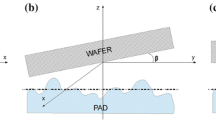Abstract
In this paper, relative velocity at a given point on the wafer was first derived. The revolutions of wafer and pad are assumed the same and the axisymmetric uniformly distributed pressure form is given. Thus, a 2D axisymmetric quasic-static model for chemical-mechanical polishing process (CMP) was established. Based on the principle of minimum total potential energy and axisymmetric elastic stress-strain relations, a 2D axisymmetric quasic-static finite element model for CMP was thus established. In this model, the four-layer structures including wafer carrier, carrier film, wafer and pad are involved. The von Mises stress distributions on the wafer surface were analysed, the effects of axial, hoop, radial and shear stresses to von Mises stress and the effects of axial, hoop, radial and shear strains to deformation of the wafer were investigated. The findings indicate that near the wafer centre, von Mises stress distribution on the wafer surface was almost uniform, then increased gradually with a small amount. However, near the wafer edge, it would decrease in a large range. Finally, it would increase dramatically and peak significantly at the edge. Besides, the axial stress and strain are the dominant factors to the von Mises stress distributions on the wafer surface and the wafer deformation, respectively.










Similar content being viewed by others
References
Runnels SR, Renteln P (1993) Modeling the effect of polish pad deformation on wafer surface stress distributions during chemical-mechanical polishing. Dielectric Sci Technol 6:110–121
S. R. Runnels SR, Eyman LM (1994)Tribology analysis of chemical-mechanical polishing. J Electrochem Soc 141(6):1698–1701
Kaanta CW, Landis HS (1991) Radial uniformity control of semiconductor wafer polishing. US Patent 5,036,630, 1991
Wang D, Lee J, Holland K, Bibby T, Beaudoin S, Cale T (1997) Von Mises stress in chemical-mechanical polishing processes. J Electrochem Soc 144(3):1122–1127
Srinivasa-Murthy C, Wang D, Beaudoin SP, Bibby T, Holland K, Cale TS (1997) Stress distribution in chemical-mechanical polishing. Thin Sol Film 308:533–537
Baker AR (1997) The origin of the edge effects in CMP. In: Proceedings of the Electrochemical Society 96(22):228–237
Yu TK (1995) Modeling of the chemical-mechanical polishing process. In: Proceedings of the Materials Research Society, ULSI-X Conferences, pp 187–194
Tseng WT (1998) Machine-related wafer pressure distribution and its influence on chemical-mechanical polishing process. In: The Electrochemical Society Proceedings, pp 457
Castillo-Mejia D, Perlov A, Beaudoin S (2000) Qualitative prediction of SiO2 removal rates during chemical mechanical polishing. J Electrochem Soc 147(12):4671–4675
Ahmadi G, Xia X (2001) A model for mechanical wear and abrasive particle adhesion during the chemical-mechanical polishing process. J Electrochem Soc 148(3):G99–G109
Yu TK, Yu CC, Orlowski M (1993) A statistical polishing pad model for chemical-mechanical polishing. IEDM Tech Dig pp 865–868
Rao SS (1989) The finite element method in engineering. Pergamon, New York
Acknowledgements
It is gratefully acknowledged that the National Science Council of the Republic of China provided funds (Grant No.: NSC 90-2212-E-237-001) for the financial support of this work.
Author information
Authors and Affiliations
Corresponding author
Rights and permissions
About this article
Cite this article
Lin, YY., Lo, SP. A study of a finite element model for the chemical mechanical polishing process. Int J Adv Manuf Technol 23, 644–650 (2004). https://doi.org/10.1007/s00170-002-1469-x
Received:
Accepted:
Published:
Issue Date:
DOI: https://doi.org/10.1007/s00170-002-1469-x



